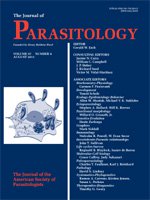A new oxyurid nematode Syphacia hodarae n. sp. is described from the cecum and rectum of the cricetid rodent Calomys laucha Fischer, 1814 (Sigmodontinae, Phyllotini), captured in an agroecosystem of central Argentina. The new species is distinguished from other members of the genus mainly by the shape of the cephalic plate, presence of cervical alae in females, absence of lateral alae, and absence of deirids. Some characters are shared with Syphacia carlitosi, a parasite of Akodon azarae from the wetlands in Argentina. However, S. hodarae can be differentiated from this species by the absence of ornamentation on the accessory hook of the gubernaculum, length of spicule and gubernaculum, size of the eggs, and distance to the vulva from the anterior end. This is the first record of a Syphacia species from the tribe Phyllotini in Argentina, and the first time a Syphacia species is reported from C. laucha.
How to translate text using browser tools
1 August 2011
A New Species of Syphacia (Nematoda: Oxyuridae) From Calomys laucha (Rodentia: Cricetidae) in an Agroecosystem of Central Argentina
Elba Juliana Rojas Herrera,
Mariela Haydée Miño,
Juliana Notarnicola,
María del Rosario Robles
ACCESS THE FULL ARTICLE

Journal of Parasitology
Vol. 97 • No. 4
August 2011
Vol. 97 • No. 4
August 2011




